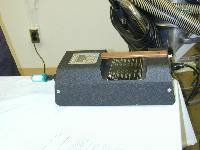
Mercury Vacuum Cleaner |
Employee exposure to mercury from accidental spills that can occur during repair of broken thermometers, sphygmomanometers, or during
sterilization and centrifugation of thermometers in maintenance areas. Mercury can also be found in some pressure-sensing instruments
(e.g., barometers and sensors in machine rooms), as well as electronic equipment, and some older, medical devices. When mercury is
exposed to the air, as in the case of a spill, it slowly vaporizes.
Potential Hazard
If spills are not promptly cleaned up, mercury may accumulate on
surfaces and then vaporize and be inhaled by unaware workers. Mercury
can also be absorbed through the skin.
Health Effects:
- Acute exposure: Acute inhalation of mercury vapor may result in toxicity including chills, nausea,
general malaise, tightness in the chest, chest pains, dyspnea, cough, stomatitis, gingivitis, salivation, and diarrhea (ACGIH 1991;
Hathaway et al.1991). Short exposure to high levels of mercury can cause severe respiratory irritation, digestive disturbances, and
marked renal damage.
- Chronic exposure: Chronic exposure to mercury may result in weakness, fatigue, anorexia, weight loss,
and disturbance of gastrointestinal function.
Possible Solutions
Good Work Practice recommends:

Mercury Spill Kit |
- Prevent the spill in the first place by replacing outdated glass thermometers, and sphygmomanometers with mercury free devices.
- Use mercury spill kits to help clean up small spills of 25ml or less. Kits should contain gloves, protective glasses, Hg absorb
powder, mercury sponges, and a disposal bag.
- Put in place procedures to isolate the contaminated area.
- Be aware that mercury can unknowingly be carried home on clothing, skin, or hair.
- Be on the look-out for this material, recognizing that it may be present in various instruments and equipment.

Mercury Vapor Analyzer |
- Use a Mercury Vapor Analyzer (e.g., Jerome) to verify that the area is safe to reenter.
- Make sure that spills are cleaned up promptly, safe, clean-up of spills by workers or a team trained in proper procedures.
- Do not allow workers who are not trained in proper procedures attempt to clean up spills.
- OSHA requires:
- American Conference of Industrial Hygienists (ACGIH) set 8-hour workplace exposure limits as low as 0.025 milligrams per cubic meter.
- NIOSH recommends:
- Clean up spills promptly with special mercury
vacuum cleaners and a water-soluble mercury
decontaminant.

Mercury Vacuum Cleaner |
- Use disposable protective equipment, (e.g., protective gloves and footwear, special mercury vapor respirators, gowns, and hoods),
while cleaning up mercury spills.
- Mercury Releases and Spills. Environmental Protection Agency (EPA).
Disposal of spills according to US EPA regulations
(40 CFR 261.24).
- Avoid using carpeting or porous surfaces on floors that would make clean-up difficult.
- Clearly post all spill areas until adequate clean-up has been accomplished.
- Medically monitor the respiratory track, nervous system, kidneys, and skin of any worker who may be exposed to mercury.
Additional Information:
|